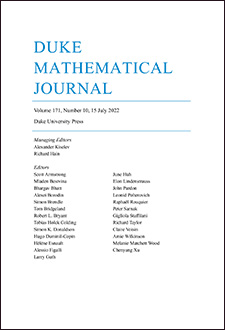Abstract
We use inequalities to completely describe the set of boundary correlation matrices of planar Ising networks embedded in a disk. Specifically, we build on a recent result of Lis to give a simple bijection between such correlation matrices and points in the totally nonnegative part of the orthogonal Grassmannian, which was introduced in 2013 in the study of the scattering amplitudes of Aharony–Bergman–Jafferis–Maldacena (ABJM) theory. We also show that the edge parameters of the Ising model for reduced networks can be uniquely recovered from boundary correlations, solving the inverse problem. Under our correspondence, the Kramers–Wannier high/low temperature duality transforms into the cyclic symmetry of the Grassmannian, and using this cyclic symmetry, we prove that the spaces under consideration are homeomorphic to closed balls.
Citation
Pavel Galashin. Pavlo Pylyavskyy. "Ising model and the positive orthogonal Grassmannian." Duke Math. J. 169 (10) 1877 - 1942, 15 July 2020. https://doi.org/10.1215/00127094-2019-0086
Information





